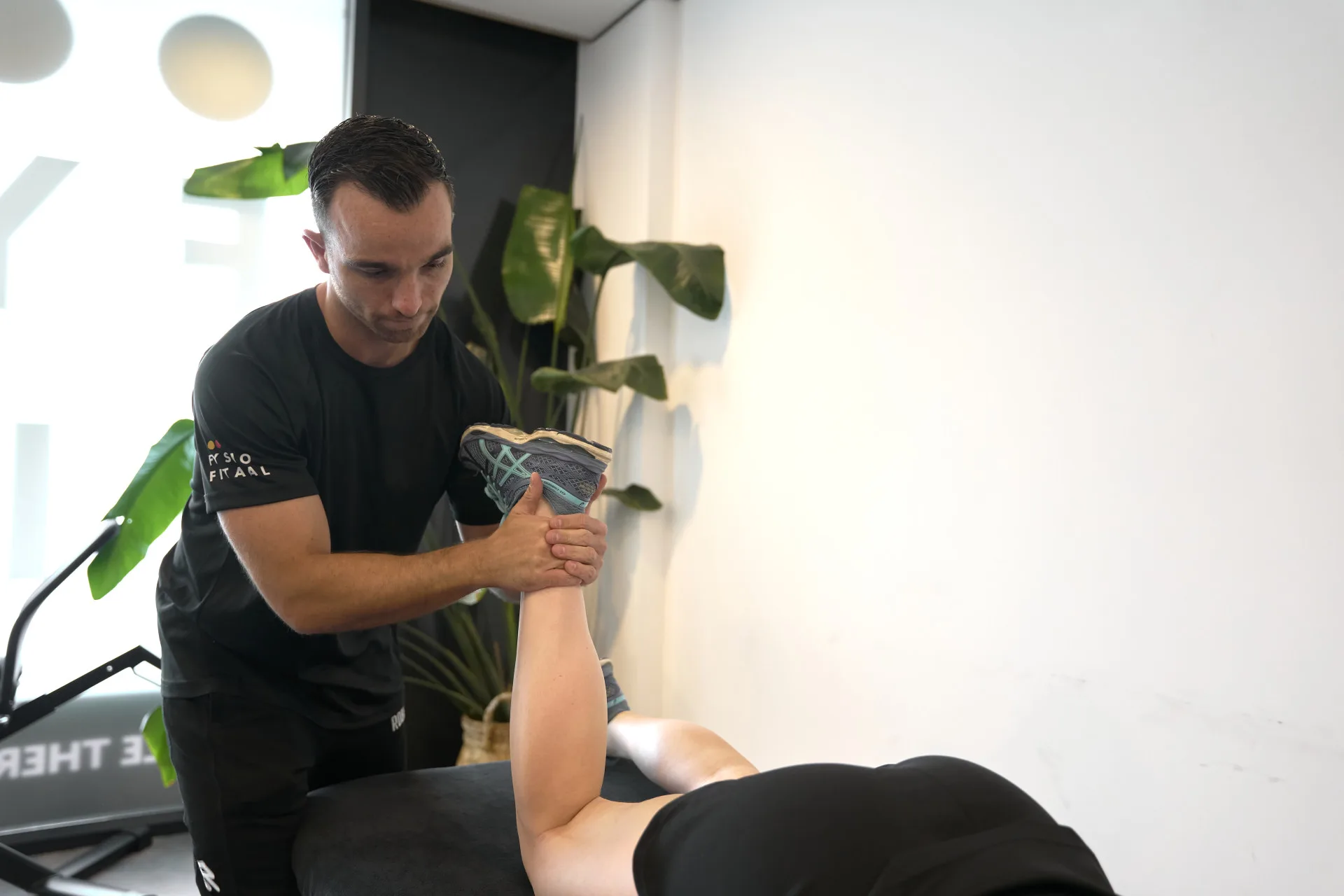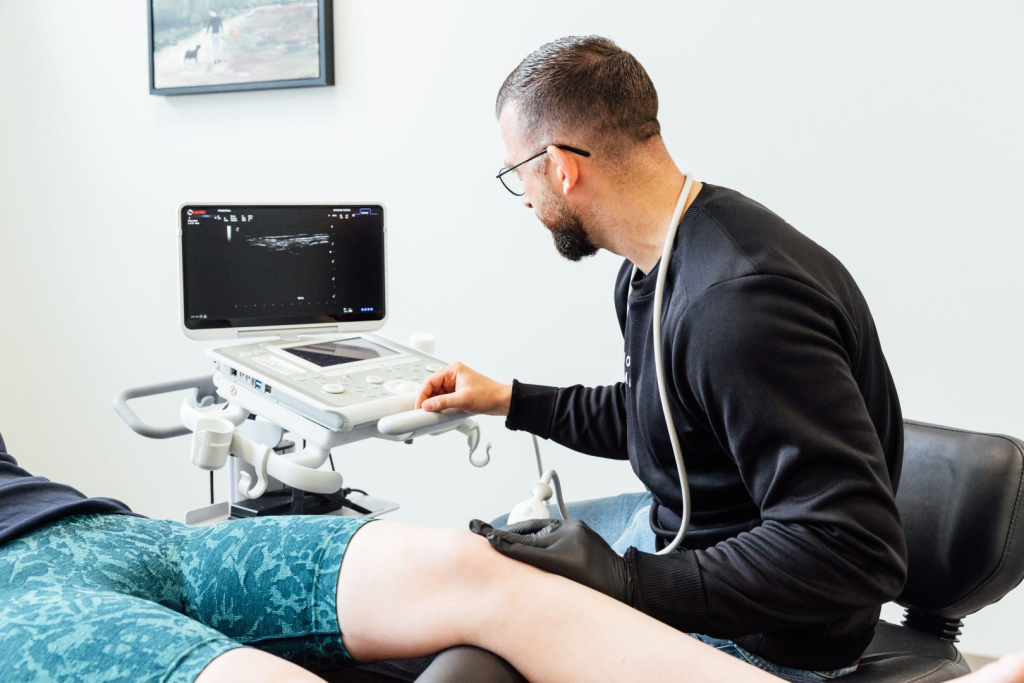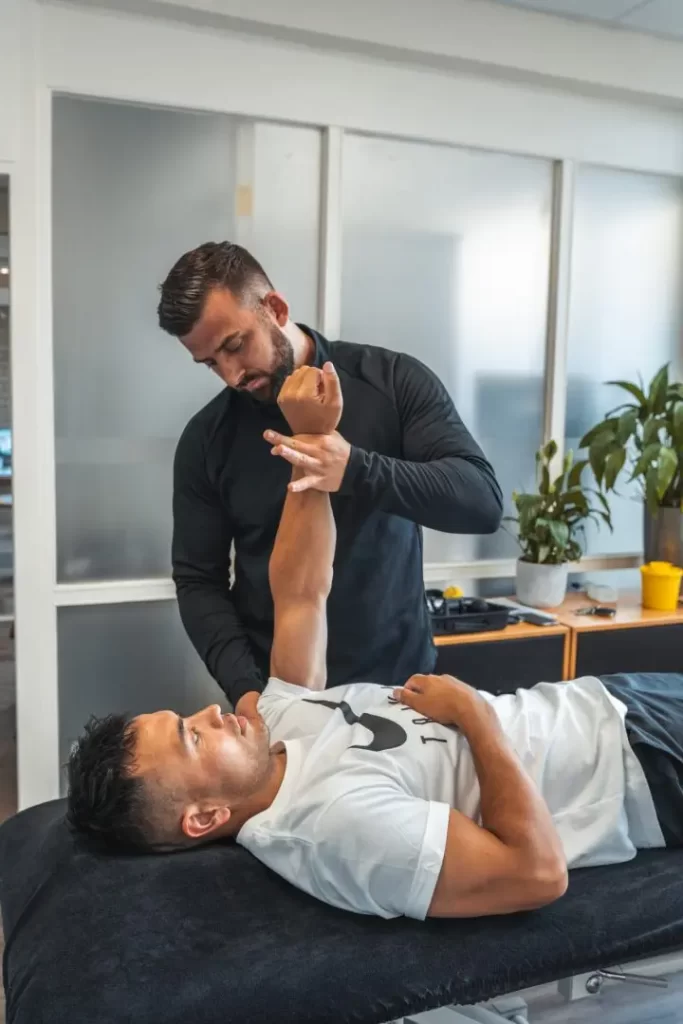Hamstring
Hamstring injuries are among the most common muscle injuries, especially in athletes who perform explosive movements. Think footballers and sprinters. The hamstrings are a group of three muscles that run across the back of the walking upper leg: the semimembranosus, semitendinosus and biceps femoris (with a long and short head). These muscles play a crucial role in bending the knee and extending the hip. These functions are often performed simultaneously during running and sprinting. This complex interplay across two joints makes the hamstrings vulnerable to overuse and injury.
During activities such as running, jumping and braking, the hamstrings absorb large forces, especially when they quickly switch between braking the extension of the knee and stretching the hip. This moment of maximum tension is often the point at which injuries, such as a tear or strain, occur. The biceps femoris is most affected here, partly due to fibre turnover and function.
At Fysio Fitaal, we understand how complex hamstring injuries can be and offer tailored treatments to optimise your recovery. Our physiotherapists combine years of experience with the latest science to get you moving again quickly. Whether you are an athlete who wants to perform at a high level or someone who wants to move in everyday life without complaints, we are here for you.

Cause
The hamstrings are subject to high forces during fast movements such as sprinting, sudden changes of direction and abrupt stops during sports. These movements require a rapid transition between knee extension and hip extension, a time when the hamstrings experience their peak load. Injuries often occur when the muscles are insufficiently prepared for this intense load, for example due to poor warm-up, fatigue and especially previous injuries.
Common Hamstring

Hamstring complaints in runners
Hamstring complaints are common among runners. Pain and loss of strength are common symptoms in hamstring injuries.

Proximal hamstring complaints
Hamstring injuries are common in athletes. Quick action and targeted Physiotherapy can...
Risk factors for getting a hamstring injury
There are several known risk factors for developing hamstring injuries:
- A previous hamstring injury
- Reduced strength of the hamstrings relative to the quadriceps
- Older age increases risk of hamstring injury
- Fatigue during sport
- Reduced neuromuscular control
- Reduced pelvic/low back control

Gradations of muscle injury
In a muscle injury, we use different degrees. Namely, it is possible that there is only muscle pain or a mild strain. But it could also be that there is a muscle tear or even a complete tear.
- 1A Fatigue of the muscle which can result in muscle tension, usually due to overuse or exercising on a different surface.
- 1B Muscle pain, generalised muscle pain of the adductors, usually caused by powerful moments of slowing down during sports.
- 2A Muscle injury due to radiating pain from the low back
- 2B A local neuromuscular dysfunction of the muscle
- 3A Small localised muscle tear less than 1 muscle bundle
- 3B Medium-sized muscle tear, multiple muscle bundles involved in the injury
- 4A (Sub)total muscle tear, avulsion fracture
- 4B Muscle contusion due to severe collision with person or object from outside
The different types of hamstring injury
A hamstring injury is one of the most common non-contact injuries in various sports. We can classify hamstring injuries into two different types. This classification is made based on the mechanism of occurrence.
A type 1 hamstring injury results from injuries caused by a sprint or peak load on the muscle group. Besides sprinting, other examples include: jumping, hurdling in athletics or a deadlift in powerlifting. When we look at sprinting, we see that this injury often occurs in the moment when the foot is just about to hit the ground. At this stage in the sprint pattern, the forces are greatest. The muscle is now firing at maximum but also needs to brake eccentrically to maintain good control of the knee and position of the foot on the ground.
- 12-16% of all injuries in professional football are hamstring injuries
- 75% of the cases involve injury to the biceps femoris
A type 2 hamstring injuries are injuries where there is a lot of stretch on the muscle. We often see this in gymnasts or dancers. This happens when the hip has to bend maximally and the muscle stretches excessively. In most cases, this is a less painful injury but the recovery time is often longer because the injury is in the upper part of the hamstring towards the tendon. This type usually involves injury to the semimembranosus.
Anatomy of the hamstrings
The hamstrings are a group of three muscles at the back of your thigh: the semimembranosus, semitendinosus and biceps femoris (with a long and short head). These muscles start at the sit bone and attach to different parts of the thigh and lower leg. Most hamstrings run over both the hip and knee joints, making them important for bending the knee and extending the hip. The short head of the biceps femoris only runs across the knee.
How is a hamstring injury diagnosed
A discolouration may be seen on the back of the leg. In addition, the picture is confirmed by pain on tightening, stretching and palpation of the hamstring. Additional examination is often not helpful in a hamstring injury. There will be little or no change in the treatment chosen. However, an avulsion fracture should not be missed.
Avulsion fracture
An avulsion fracture occurs particularly after an accident where the knee is forced to be extended and the hip flexed. An example is slipping with your leg forward. There is blue discolouration of the back of the leg in all cases. There is also substantial pressure pain on the sit bone. When there is an avulsion fracture, there is no tension felt from the tendon that attaches to the sit bone. In this case, an MRI or ultrasound scan is necessary.
The different stages in the treatment of a hamstring injury
Successful rehabilitation consists of several stages and steps. Good strength, coordination and optimal movement patterns are necessary to safely return to your sport.
Adjusting the (training) load
In this phase, we mainly focus on symptom reduction. There is often swelling, pain and reduced mobility of the hip and knee. Therefore, it is important to regain good control over your hip and knee movements. After a hamstring injury, we often see a change in the walking pattern. It is therefore important to quickly regain proper function of the muscle.
Strength and coordination phase
In this phase, there is more of a build-up in strength. How quickly this is built up depends on the hamstring's reaction to the given load. Because the risk of a new hamstring injury is high after a previous injury, it is extremely important to make a sustainable build-up in strength and coordination of the hamstring and the rest of the chain. This is often vastly underestimated and the risk of a new injury is higher than intended.
Sports-specific phase
The final phase focuses particularly on maximum strength, jumping power and explosiveness. This is all needed to quickly change direction within your sport. Competitive fitness is also worked towards so that you can continue to perform under fatigue. The quality of movement must remain good under these conditions. One of the key pillars are high intensity runs, it is seen in the literature than individuals sprinted significantly less often after a hamstring injury, if they did there was a greater chance of relapse/re-injury. the importance of a good build-up in high-speed sprints is therefore extremely important.
Sports resumption
The timing of sports resumption remains a difficult decision. This is because there are no clearly proven criteria for sports resumption. Wanting to start again too early often leads to a new injury. In all cases, the athlete should be able to sprint again pain-free, maximise hamstring tightening and perform sport-specific skills (shooting a ball). In addition, a dosed build-up in training must be made before (league) matches can be resumed.
Physical tests for a Hamstring injury
The diagnosis of hamstring pain is often already clear when there are visible symptoms such as discolouration, swelling or pain at the back of the thigh. To confirm the suspicion, several physical tests are performed in which the symptoms are deliberately provoked. During these tests, pain, loss of strength and restriction of movement are examined, which helps to determine the severity and location of the injury.
At Physio Fitaal we additionally use ultrasound to get a detailed picture of the damage. With ultrasound, we can accurately determine if there are tears, swelling or other abnormalities in the muscle tissue. This helps us not only to confirm the diagnosis, but also to tailor a treatment plan tailored to the specific nature of the injury. Ultrasound is a valuable tool to monitor the recovery process and make adjustments in treatment when necessary.
Hamstring strength test
Hamstring strength test
Stretching and palpation of the muscle group
Stretching and palpation of the muscle group
Making an appointment at FysioFitaal
We work from multiple locations in Tilburg, always close by for professional and accessible physiotherapy. Fill in the contact form and we will contact you soon. Together, we will work on your recovery!

